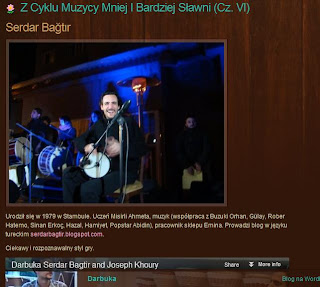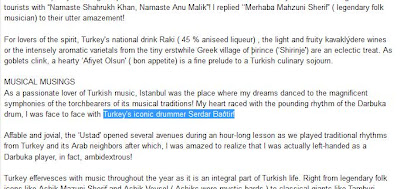He was born in Istanbul at 1979.
When he was nine he began to learn playing DARBUKA with his family support. He studied classical Turkish Music in association of Turkish music in five years.
He founded group of rhythm "SINA" at 2005 and he worked in SHAMAN Dance Music and Rhythm Theatre between 2003-2008.
After various experiences in traditional Turkish Music, Folk Music, Flamenco, Indian Rhythms, Greek and Arabic Music, he participated in several music records.
In addition, he had many solo and joint concerts such as 45. Troia Festival (with Sina), Bulgaria and Romania...
Nowadays he teaches music and holds concerts, workshops and...
Some News About Serdar BAGTIR
INDIAN EXPRESS NEWSPAPER
RUSSIA http://darbukapl.wordpress.com/
USA http://peace-makingthroughmusic.blogspot.com/2011/06/one-part-of-peace-making-through-music.html
Learning
the Modern Turkish Style
Serdar Bagtir loves both
playing and teaching the darbuka.
What he enjoys most on teaching is
to see the progress of his students.
Some of them even became
professional players.
Serdar noticed an
increased interest in the modern Turkish split hand technique in the
last years. That’s why he has been teaching students from all over
the world who come to Istanbul and enjoy the pleasant and skillfull
teacher. As an “ambassador” of the modern Turkish darbuka
technique, which was developed by his master Misirli Ahmet, Serdar
enjoys a very good reputation on being a very friendly and
approachable, but also an affordable teacher. Besides the advantage
of speaking English the teaching system of Serdar is very intuitive
and modular, hence very effective. According to the level of the
student Serdar builds on their knowledge and expands their rhythmical
and technical know how. He shows how to perform the basic strokes of
the darbuka and the doholla including the new sounds of the modern
Turkish style (like the kik-sound or the tek-slide) correctly. Serdar
teaches traditional as well as modern grooves based on rhythmic
patterns which can be used for all kinds of musical genres. The
tutorials usually take place in rehearsal rooms in the famous Tünel
district where the music stores of Istanbul are located. So why are
you still waiting? Take the next opportunity and come to Turkey to
learn the secrets of the modern split hand technique from a true
master. Besides learning the darbuka you can enjoy the atmosphere of
Istanbul and gain many precious moments. For more information don’t
hesitate to contact Serdar.
Please check this link for contact http://serdarbagtir.blogspot.com/p/iletisim.html
The Nitty Gritty of Darbuka Playing
1) Please let us remind
that the term Darbuka derivates from the Arabic word darb I ka. In
Turkish darp literally means hit or beat. So make sure each stroke is
played precisely. Keep this also in mind when playing fast and stress
on repeating the exercises again and again. One has to be patient and
practice a certain exercise or a piece as often as needed to be
capable of playing it fast.
2) Make sure you warm
up before playing and stretch the muscles after playing to prevent
physical injuries like tendonitis or carpel tunnel. Also these
exercises will help building up the muscles.
3) Don’t forget to
drink enough water especially during summertime in case of hot
weather.
4) To
help the body internalise the rhythms or pieces you are playing, it
is necessary to repeat the units a lots of times. There is a Chinese
proverb that says it takes 8000 iterations until an exercise has been
internalised by mind and body.
5) It is absolutely
necessary to use a metronome for the exercises and rhythms you are
playing. Even if there are times where you doubt the sense of using a
metronome – believe me it promotes your progress enormously.
6) To extend the life
of the natural skins of the clay darbukas it
is recommended to obey some rules: Put a towel on the skin of the
instrument to prevent absorbing too much humidity. The natural skin
darbukas shouldn’t be kept in drum bags. There should be some kind
of air circulation, however make sure there is no direct solar
radiation. At times if you feel the skin is too dry or dirty you can
even wipe the skin with a wet cloth.
7) During the months in
the summer you don’t need to warm up a lot as the muscles are
warmed up already due to the warmer environment so enjoy being able
to practice immediately and just practice even more!
8) Some of you cannot
play loud in their apartments so to be able to practice however you
can put a t-shirt on the upper body of the darbuka (where the skin
and the rim is located). Please don’t cover up the bottom part of
the darbuka. This could have a negative effect on the bolts and the
screws in the rim of the drum because of the vibrations of the doum.
9) With rain and sudden
fall in temperature the pitch of the sound
of the natural skin will go down. Unfortunately a lot of people put
on the light bulb (installed inside of the darbuka) at maximum heat
to tune the skin. I am against this logic unless you are within a
recording session or playing an outdoor concert. In such weather
conditions I recommend to cover the whole darbuka with a thick towel
to keep the skin dry.
10) Don’t think too
much about those goals you haven’t accomplished. Just start to
practice the exercises or pieces you want to master at a very slow
tempo and play them over and over again until you are comfortable
with playing it. Only then increase the tempo.





Hiç yorum yok:
Yorum Gönder